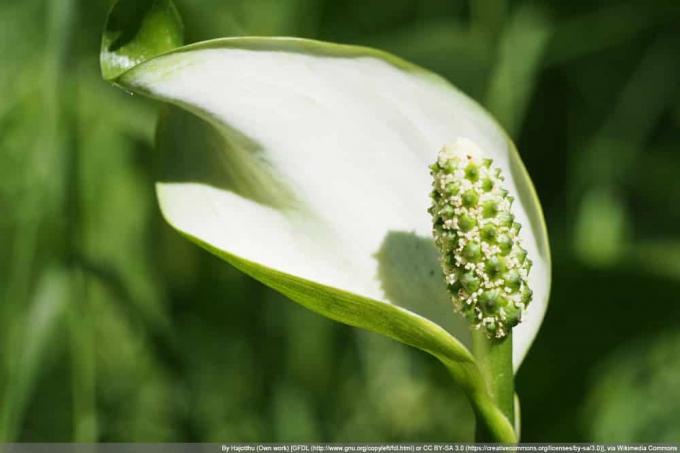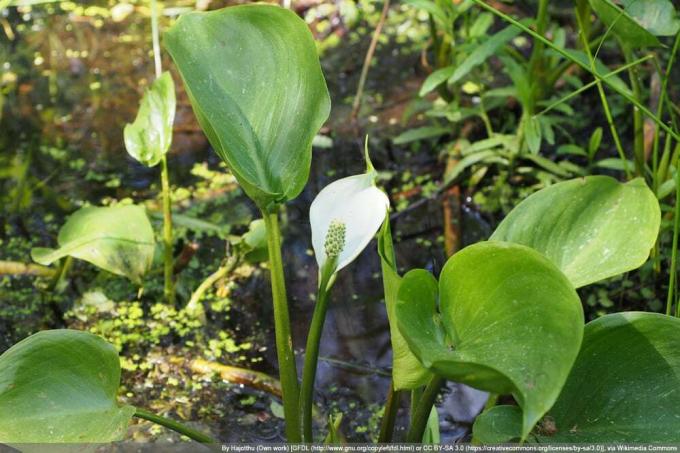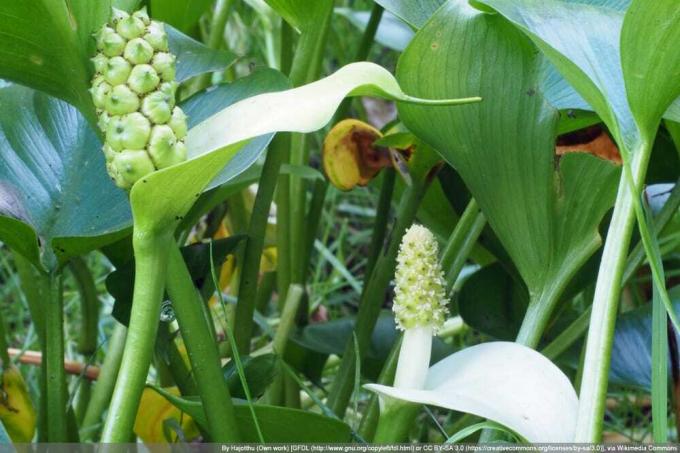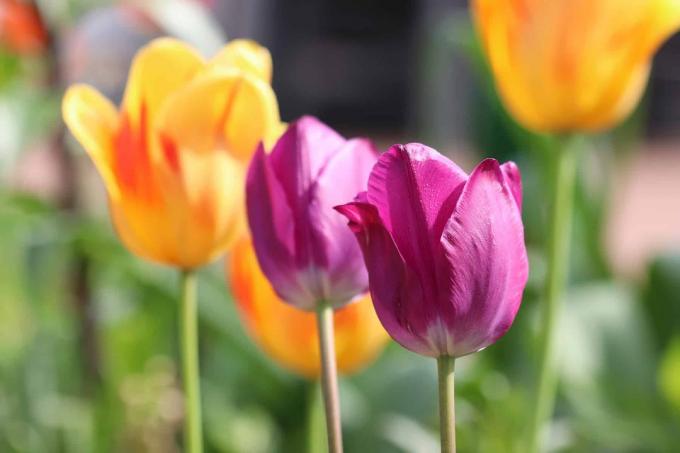

Table of contents
- Location
- substrate
- Plant
- Pour
- Fertilize
- waste
- repot
- propagation
- division
- germination of seeds
- wintering
- Typical care mistakes, diseases and pests
- Caution: Toxic
The decorative calla plant is comparatively undemanding, but as a marsh plant it still needs special, adapted care. The most important factors are the substrate, the location and the water. Interested hobby gardeners can find out here which factors to look out for and what special needs the swamp calla has.
Location
The swamp calla already reveals where the dragon arum feels most comfortable - in swampy, damp locations. It is therefore ideal as a plant for the edge area of the garden pond. Depressions and areas with high groundwater are also well suited for the calla plant. Apart from the moisture, the location should be sunny to semi-shady. If the swamp calla lily lacks light, it tends to rot.
substrate
The calla plant needs a nutrient-rich substrate that is loamy and can store moisture well. In addition, it should have a neutral to slightly acidic pH value, because dragon root is sensitive to lime. The easiest way is to use pond soil directly for the swamp calla. This is already optimally designed for the requirements of the crop. With garden soil and mixtures, there is a risk of mold and rot due to the high water requirement.
If you still want to try, you can use mature compost and high-quality garden soil and mix them with sand to form a loose substrate. In any case, it is important that the substrate is always kept moist. A water level of five to ten centimeters above the ground is even ideal.
Plant
The calla plant is best planted in spring or used in the pond. It can be planted directly on the bank or edge of a pond or placed in a plant basket in the water. In this way, substrate and roots remain compact in one place and can be easily removed again if necessary. Nevertheless, the soil can absorb sufficient moisture.

If the swamp calla is not to be in a pond or body of water, it can also be useful to place it in a plant basket or planter. For example, the dragon root can be removed much more easily in order to multiply it. It is also beneficial to limit the water drainage through a vessel. This reduces the effort for watering and the conditions for the calla plant can be optimally designed more easily.
Pour
Of course, if the calla plant is in a pond, it does not have to be watered. In a bucket or other planter, care should be taken to ensure that the water level remains as high as possible. Planted outdoors in a drier spot, on the other hand, needs to be watered frequently. In the case of the swamp calla, the location decides how much effort is required for watering.
Tip:
It is also important that soft, low-lime water is used.
Fertilize
When it comes to fertilizing, the Drachenwurz is particularly undemanding and easy to care for, because an additional supply of nutrients is not necessary in the pond. It should also be avoided in mini ponds, outdoors or in buckets. Instead, a change of substrate is the better choice for the calla plant. However, this is rarely necessary.
waste
The flowering period is between May and July, after which fruits develop. In this case, blending is only necessary if fruit formation is to be prevented. Only in autumn does the plant retreat into the rhizome, so the above-ground part withers. It can then be blended in the fall or in the spring.
This is not absolutely necessary for the health of the plant, but it reduces the risk of rot, especially in smaller bodies of water and containers, and is also visually more appealing.
repot
Since the calla plant should not be fertilized, nutrients can only be supplied in two ways. On the one hand through pond water and the natural nutrients in it, which are made available due to decomposition processes and microorganisms. On the other hand through a nutrient-rich substrate. If the swamp calla was not placed in a body of water or planted outdoors, it may be necessary to change the substrate. This should be carried out every two to three years as follows:
- The substrate is heavily watered so that it is already wet and soggy.
- The rhizome is carefully removed from the soil and freed from the remains of the substrate. It makes sense to rinse the root thoroughly.
- The rhizome is placed in fresh, dry substrate and covered with it. Fresh pond soil or the mixture described above can be used for this.
- If the vessel is to be put back into a mini pond or a bucket, it should first be poured out or placed in a bucket of water. Loose substrate is removed in the process.
propagation

The propagation of the calla plant is possible in two ways.
division
The simplest variant is the propagation of the dragon root by dividing the rhizome. The procedure is as follows:
- The root of the swamp calla is removed from the substrate in early spring and cleaned with running water.
- The root is divided in half with a sharp knife. There should be two sections of the same length as possible.
- After the cut surfaces have dried briefly in the air, the resulting rhizome halves are placed back into the substrate.
When propagating by division, it should be noted that the rhizome has a dead section due to the "snaking" expulsion. This part looks soft and rotten, but does not necessarily need to be removed. However, it should be taken into account and subtracted when dividing into two halves as evenly as possible, so that the resulting daughter rhizomes are about the same length.
germination of seeds
The second variant of propagation is the germination of seeds, which is much more complex and requires more patience than division. To do this, you first have to wait for the flowering phase of the swamp calla, which can take up to a year after planting. Following this, the dragon root forms red fruits. When these ripen and eventually dry up, they can be harvested and opened. The seeds contained are freed from the pulp and skin and then stored in a dry, dark and cool place until spring.
After that, they can be germinated as follows:
- A shallow seed tray with no water drain is filled with potting soil. There should still be about two to three fingers between the substrate and the upper edge.
- The substrate is well moistened. The water may be just above it. However, it is also sufficient if it is poured overflowing and is therefore damp to wet.
- The seeds of the swamp calla are now lightly pressed individually into the substrate at a distance of about two to three centimeters. Since this is difficult to do with just your fingers, you can use tweezers, a match or a toothpick to help you plant the seeds in the ground.
- Since the substrate has been wetted by flooding, a cover is not necessary. However, care must be taken that the soil does not dry out.
- The culture vessel is placed in the brightest possible place and should be exposed to temperatures between 18 and 20 °C.
Under optimal conditions, it takes about two to three weeks for the seeds to germinate. However, it can also take a long time. As soon as green shoots are visible, the distance between the seedlings can be increased. So it makes sense to spread the young plants over several growing vessels. When they have reached a height of 10 to 15 centimetres, they are allowed to go outdoors.
Tip:
Gloves should be worn both when dividing and removing the pulp to avoid direct skin contact with the plant sap.
wintering
The calla plant is easy to care for during the winter because it is hardy and can therefore be left in place. It should only be noted that the dragon root withdraws into the rhizome from autumn. The leaves wither and dry up and the swamp calla sprout again in the spring.

If the calla plant was cultivated in a bucket or a mini pond on the balcony, it can also be overwintered indoors. Here it can stand dark and cold, but should be kept as frost-free and moist as possible. It is important to ensure that the rhizome does not dry out completely. Only then does the swamp calla run the risk of being damaged during the winter.
Typical care mistakes, diseases and pests
The calla plant is largely spared from diseases and pests, but mistakes in care can lead to problems. The most harmful are:
- dryness
- Calcareous water or substrate
- Withered plant remains
As a marsh plant, the dragon root does not tolerate drought very well. It doesn't have to be in water all the time, but the substrate needs to be kept at least moist all the time. If it dries out, damage will occur. Floating watering or placing in water can at least save the rhizome. Lime-rich water or substrate prevents the calla plant from absorbing nutrients. This quickly leads to an undersupply. The only remedy here is a quick repotting or a change of substrate.
Withered plant sections are not a problem if the swamp calla is in a larger body of water or has been planted outdoors. However, in mini ponds or a small bucket of water, they can cause problems and cause rot. In addition, the water can “tip” as a result, i.e. become too rich in nutrients, algae and silt. If withered shoots were not removed in time, subsequent pruning and a water change will be necessary.
Caution: Toxic
All parts of the swamp calla are poisonous. If it is to be planted, cut or propagated, gloves should therefore be worn. It should also be noted that the dragon root develops red berries after flowering. At first glance, these appear tempting and edible, but they are also poisonous. Children and animals should therefore be kept away from the calla plant or the plant in the garden should be avoided.
 Home editorial office
Home editorial office
Learn more about flower bulbs

Tulips do not bloom and only put out leaves: what to do?
Tulips are among the most popular spring bloomers. They are therefore extremely common in domestic gardens. However, various causes can lead to the onion plants only developing leaves and no flowers. You can find out what to do in this case here.

Madonna lily, Lilium candidum: 9 care tips
Due to its growth height of more than one meter and the imposing white funnel-shaped flowers, the Madonna lily is one of the most impressive native bulbous plants. What to look out for when caring for this impressive flower is summarized in 9 clear care tips.

Daylilies, Hemerocallis: care from A – Z
Daylilies (Hemerocallis) are among the loveliest and most rewarding flowering perennials. Even if each individual blossom lasts only one day, countless new blossoms form again and again and decorate the garden for weeks. In addition, they are available in almost every color imaginable.

Freesia, Freesia: care tips from A - Z
Freesias are popular summer plants because they are colorful and have a pleasant, delicate scent. The irises, originally from Africa, are not difficult to care for, but do not tolerate frost. You can easily propagate the freesias yourself using the bulbs.

Milk Star, Ornithogalum: care from A to Z
The Orange Milk Star (Ornithogalum dubium) is a popular ornamental plant from the Cape Province. Because of its decorative flowers, it is often used as a cut flower in flower arrangements. The ornamental plants are undemanding, but should be cared for with caution due to their toxicity.

Checkered flower: care from A to Z | Instructions
The checkered flower (Fritillaria meleagris) attracts everyone's attention with its bell-shaped flowers. The reason for this is their striking pattern, which is strongly reminiscent of a chessboard. This striking check pattern shows the bulb flower in different shades.
